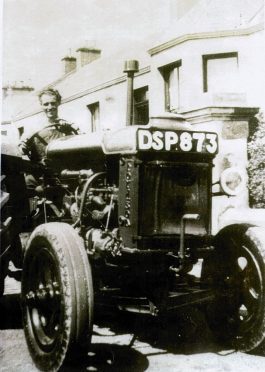After a nine-year break because of WWII organisers followed the rotation of areas by giving Inverness and the north the honour of hosting the first post-war Highland Show in 1948.
The town council offered Bught Park and laid on water and police presence free of charge. Tradesmen erected the showyard for the opening of its four-day run on Tuesday, June 22.
Fuel rationing was still imposed so long distances were covered by rail.
However one sheep exhibitor found another method of transport – W.F. Osborne of Hatton Farm, Leven in Fife, had entered five Oxford Down and Suffolk sheep.
He chose his trusted young tractorman, Arthur Suttie, to drive them there with his Fordson N tractor. The tractor was thoroughly serviced and a 12 volt battery and lights fitted. Two trailers were prepared with the front one having a canopy to cover the sheep and a drawbar to tow the second trailer which carried the feeding, tack, spares, fuel and the Osbornes’ booze.
On the preceding Friday 19-year-old Arthur had his tea at his mother’s in Lundin Links before going back to the farm to set off for the night-time journey. At 7.30pm to rousing cheers from the cottagers Arthur and the Osbornes’ shepherd, Gordon Lamond, set off on the 150-mile journey. Arthur had never been to the Highland or north of Perth before.
Gordon stood on the footplate as they headed north from Perth but after a while of being exposed to the fumes from the exhaust of the cabless tractor, he went back into the trailer for a lie down as Arthur ventured on alone.
Every town and village in north Perthshire was passed through on the old A9 with a refuelling stop at Killiecrankie while revellers leaving a dance in Blair Atholl Hall must have been surprised at the sight of a Fordson and its trailers passing through so late.
The light nights meant Arthur only put his headlamp on when cars approached. By Dalwhinnie, Arthur was getting weary, seeing a light ahead he thought it was an oncoming car but as it grew no nearer he thought it was habitation and his spirits rose, however when it was eventually reached it turned out to be on the adjacent railway.
By this time Gordon had woken and was trying to catch Arthur’s attention by shouting but the engine noise drowned him out, he threw sheep feed only to see it returned by the slipstream. Eventually he jumped off the back and ran alongside until he caught up with Arthur. One stumble would have left him by the roadside by an unaware Arthur.
They decided to open the booze and a nip of gin perked Arthur up no end. No doubt the Osbornes had instructed Gordon to take a turn at driving but Arthur was too proud to let go of the wheel. On and on they went until up over the Slochd and down into Daviot. Then it was into Inverness and over the bridge and along to Bught Park. They arrived in the showground at 8am on the Saturday morning and unloaded and sorted the sheep, before being allocated a wooden stockman’s hut for a well-earned rest.
Wet weather preceded the show and Arthur helped pull in beer lorries with his Fordson. In between working with the sheep he helped a woman from the north with her Highland ponies. He remembered the entertainment laid on at night in a big tent including a man playing the saw.
The King, Queen and Princess Margaret attended – the first time a reigning monarch had graced the Highland and King George bestowed the royal title on the society that week. They toured the show, presented long service medals and inspected the Woman’s Land Army. They also watched a special March of Time pageant which included agricultural displays and equipment from the earliest of times to contemporary machinery of the period.
The livestock parade featured native breeds and one of the champions was W.F. Osborne’s Oxford Down tup lamb.
By the closing Friday it was time to load up and travel to the harbour to refuel before an uneventful journey home to Fife arriving on the Saturday morning after the show.
